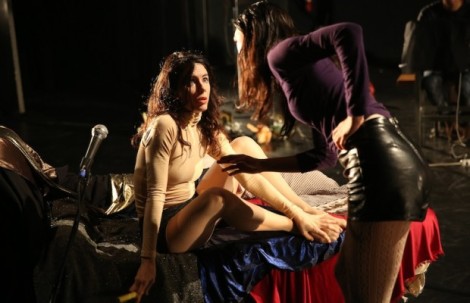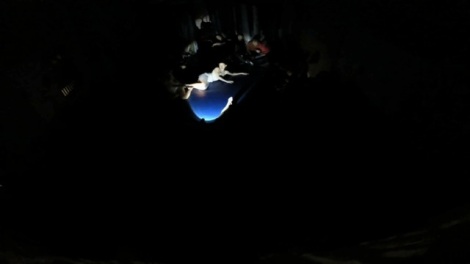
Jennie MaryTai Liu is a director and choreographer of experimental performance originally from Hong Kong. Her most recent work, the multimedia Actress Fury, had its premiere in the 2013 New Original Works Fest (N.O.W. Fest) at the Roy and Edna Disney/CalArts Theatre (RedCat.) Actress Fury will have an extended world premiere at The Bushwick Starr in February 2014 and stars Ms. Liu, Hannah Heller, and Alexa Weir. In addition, the multihyphenate debuted her first short film as director, editor, and performer in the 2012 Chez Bushwick Presents commission Scout Hut. Ms. Liu took time from her busy preparation schedule to speak with Sean Malin of CineMalin: Film Commentary about what her artistic identities entail, the value of expanding a work’s breadth, and what direction her film career is heading towards. This interview, the second of two parts, has been edited and compressed from e-mail for publication.
*****
SM: You and your cohort performed Actress Fury three times across a weekend. How much did it change from performance to performance? Do you value those changes and the unpredictability that comes with live theatre, or are they detriments to your intention coming through as clearly as you’d like?
JMTL: Whatever your medium, as a creator you place so much care in the crafting of each moment. We experiment with many different ways of doing things, and make choices based on what we like best. So of course I want the performance to unravel in the way we rehearsed it, and for nothing to go terribly wrong. It’s a trope, but the beauty of live performance is the encounter with the audience – there is a transference of energy that makes the event special. My friend Karinne Keithley Syers, who is a much more accomplished multihyphenate artist than me, wished before our RedCat show that the performances be the kind that can be learned from. That’s more the true wish– to hope that what you have made has life enough of its own that it will reveal to you ideas and feelings you had not anticipated.
Having said that, the fineness with which you can craft the viewer’s attention in video is such that it makes for a much better medium for aesthetic obsessives. For most of the time, your audience is at home sitting in front of their computers, and can pause or flip off your work at any time. At least in the theater, you have the audience there in one place where you can keep an eye on them.
SM: As we speak, you’re preparing to premiere an alternate version of the work at The Bushwick Starr in February. What changes have taken place behind-the-scenes in the work up to the premiere?
JMTL: The Bushwick Starr offered us four weeks in the theater before our three-week-run to finish the piece and work with sets and lights. That’s a pretty unheard of gift in the theater world. Seven weeks is an immensely generous amount of time to have in a performance space. We raised about a third of our total budget through small local grants and some money that RedCat gave us. We successfully launched a crowdsourced fundraising campaign through Hatchfund, a platform which remains free to artists, in order to see us through until we get our share of the box office. We get a large percentage of the box office, too.
SM: Tell me a bit about your influences on this piece – which work in any field did you expressly look to for guidance? Who or what made its way directly into the work through visual or sound or performance “quotes?”
JMTL: One of the first sources for me was Harmony Korine’s Spring Breakers (2013). I admired the broad emotional tone, and the fury of the female characters. It made me want to make something where the people were defiant. On YouTube, there is a wonderful set of 1960s home movies by Roddy McDowall of celebrities including Lauren Bacall, Rock Hudson, and Natalie Wood all just hanging out together at his Malibu beach house. I loved the easy style with which the actors performed for each other and the candid camera in these social gatherings. The color and vivacity of Super-8 [film] has inspired a quality in our performances. There are also some brilliant home videos of Joan Crawford doing things like lighting a cigarette, which we learned gesture-by-gesture for Actress Fury. Cassevetes’s Opening Night is a big influence, as was Gena Rowland’s performance in Woman Under the Influence. The rigorous painting and writing of British abstract artist Bridget Riley is becoming a big influence on the work…
SM: Though Actress Fury is a live performance, it includes several aspects of good filmmaking. Elaborate sound and set design, dramatic lighting, costuming. Can you see the piece translating to video or film without a hitch?
JMTL: Part of my impulse to put the audience in the space with the performers and have them be mobile in that space is to break up the limitations of the single vantage point of a person, space, or thing – which is exactly what camera technique and film editing do. In film, you only have one frame (for the most part.) The filmmakers have tyrannical control over what they want their audience to look at. In theater, the audience’s gaze has so much multiplicity; you can use lighting and composition to guide their attention in certain directions, but you can never control what they are looking at. The stage picture is too wide…maybe if you were working with a stage the size of a TV.
So you have this cool paradox: in film, you can flip the viewer front, back, sideways, underneath, and you can guide them around the back of a person’s head or swoop them over a valley. The film audience can be taken on a wide and specific journey, but they can only go exactly where you tell them to go. In theater, we are compositionally limited by space and time, but the attention of the audience has this wonderful refraction. No two eyes are seeing the same thing.
We will be shooting Actress Fury in New York and have the luxury of using multiple cameras to try to replicate the sense of the roaming gaze, and the constant layering of action on top of action. We’ll be shooting it like an extended party scene, or even a battle scene, where the camera is enmeshed in the action and the camera can create slippages between bodies and characters. This means that not everything of the live performance will get documented. It will be exciting to make some tyrannical cuts.

SM: You also directed a short film, Scout Hut, which you edited and performed in. Is now a good time in the world to be a dance filmmaker? Some might say we’re experiencing a renaissance and others might say there will never be a good time, financially or culturally, for dance outside of Fame or Dirty Dancing to find a big audience through cinema.
JMTL: Although Scout Hut did have a ‘dance’ in it, I’m less interested in making ‘dance film’ than in making narrative films that are colored by the choreographic processes and philosophies of dance. I am interested in the nuances of behavior and gesture, and in how images are strung together to play with our perception of time and feeling, creating a dance-like experience. I’m also interested in performances that extend the frame of what is considered ‘normal’ movement for a person to inhabit. Gena Rowlands’s performance in Woman Under the Influence demonstrates this idea, it’s eccentric, it’s rhythmic; it’s more than just full-bodied acting – her movement itself becomes an expressive tool in the movie.
An example of the dance-like or choreographic is in one of the first sequences in Shane Carruth’s Upstream Color (2013). In the sequence, two boys are high on the residue of whatever insect is causing everyone to go bonkers. Their eyes are closed and their hands are articulating invisible structures in the air. A human experience is being presented without words [here]. I found that moment to be a magical example of how dance, even just the philosophy or compositional strategies of dance, can infiltrate film and the film audience. Gravity (2013) was absolutely choreographic. Alas, the wordless version that Cuaron initially imagined will remain imaginary…
SM: I’d like to turn the tables a bit, if I may. At CineMalin: Film Commentary and Criticism, we – and I, specifically – have experience interviewing filmmakers, editors, screenwriters, producers, and actors. My formal education is in Cinema and Media Studies. If someone with my training and background were to come to your performances and create critical analysis around them, would we – or I, who have seen much of your work – be exceeding the limits of our trained ability?
JMTL: No, I would love to see what critical analysis you would create around my performances. I try not to make performances that you need a code to crack – there is nothing specifically to crack. Though your analysis might be more interesting if you knew the lineage of experimental performance and could trace the work within those references.
SM: Would it be inappropriate in your eyes for a film critic, trained or untrained, to craft reviews or criticism around your performance pieces? And what about a filmmaker ‘reading’ your work?
JMTL: My brother and my boyfriend are both directors, so I am constantly being judged by filmmakers. I ask for it. I am really interested in the idea of a cross-disciplinary web of criticism. Our fields can get so exclusive, incestuous, sychophantic and apathetic. Having fresh, beginners minds on our work can only be invigorating. People from other fields may ask more of you, and you have to work harder to articulate what you believe to be ‘given’ about your work. The languages of film and performance are so close – space, time, story, emotion, movement, character. I would feel less prepared to give a review of a visual art exhibition or a music concert.
SM: Has Actress Fury led directly to new opportunities for you, or gotten you a level of attention you hadn’t expected?
JMTL: Showing the work at REDCAT was useful to me as it was the first time a Los Angeles audience has seen my work. Through the show I met Brian Getnick, curator of Native Strategies, which led to the opportunity to develop work at his new space, PAM. I hope the show will garner some attention in New York and lead to opportunities to tour with the work. My next piece is going to be a process-driven film to be created with an ensemble cast and shot in a year on my 7D in a small rehearsal space. My first order of business when I finish Actress Fury is to raise money to put down a deposit on a year-lease on an interesting space somewhere cheap.



